Tulip Trees (Tulip Poplar, Yellow Poplar, and Chinese Tulip Tree): Leaves, Flowers, Bark (Pictures) – Identification
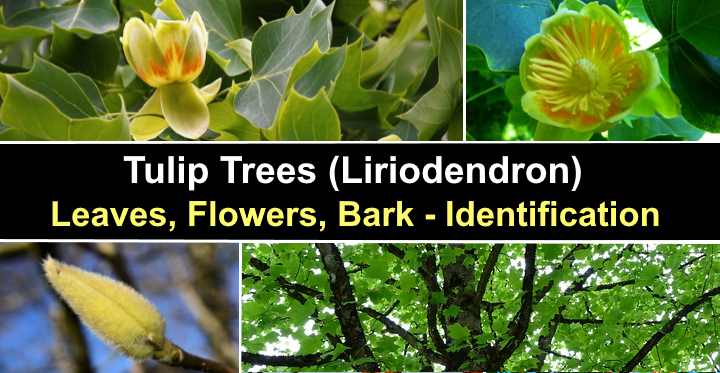
The tulip tree (Liriodendron) is a large flowering tree with yellow tulip-like flowers, distinctively lobed leaves, and thick furrowed bark. From the two species of tulip trees, the Liriodendron tulipifera is native to North America. Also called the tulip poplar or tuliptree, these impressive trees are easy to identify in landscapes with their straight trunk, oval or pyramidal canopy, yellow-green flowers, and beautiful golden yellow fall colors.
Although the common names of Liriodendron trees are tulip trees or tulip poplars, the tall trees are not closely related to poplar trees or tulips. The trees with their unusual maple leaf-like foliage are related to magnolia trees. Other names for the tulip poplar include yellow poplar, saddle-leaf tree, tuliptree magnolia, and fiddle tree. Its botanical name means “lily tree.”
This article is a guide to identifying the two types of tulip trees—the American tulip tree (Liriodendron tulipifera) and the Chinese tulip poplar (Liriodendron chinense). Descriptions and pictures of tulip tree bark, leaves, and flowers will help to recognize these majestic deciduous trees.
Facts about Tulip Trees
Tulip poplars are two species of deciduous trees in the genus Liriodendron and magnolia family Magnoliaceae. Tulip trees grow between 60 and 160 ft. (18 – 50 m) tall and have a pyramidal crown measuring 30 to 50 ft. (9 – 15 m) wide in their native habitat.
Tulip trees thrive in USDA zones 4 to 9. Tulip trees are relatively fast-growing but grow for between 15 and 20 years before the trees produce flowers. Cup-shaped or trumpet-like flowers appear in late spring and complement the bright green, unusually shaped leaves. Being a type of deciduous tree, the tulip poplars lose their leaves in the fall when the foliage turns golden yellow.
The tulip poplar is one of the tallest hardwood native trees in North America. The tree’s straight trunk and high-branching growth habit make the yellow poplar an important tree in the timber industry. Although classed as a hardwood tree, yellow-poplar timber is strong yet relatively soft, almost as soft as pine wood.
The American tulip tree is the state tree of Kentucky, Indiana, and Tennessee.
An issue with growing tulip poplars in garden landscapes is that they can be messy. Apart from their enormous size, the flower petals and autumn leaves can litter the ground. Additionally, the trees secrete a sticky sap that sticks to cars, paths, and driveways.
What Is Tulip Magnolia (Pink Tulip Tree)?
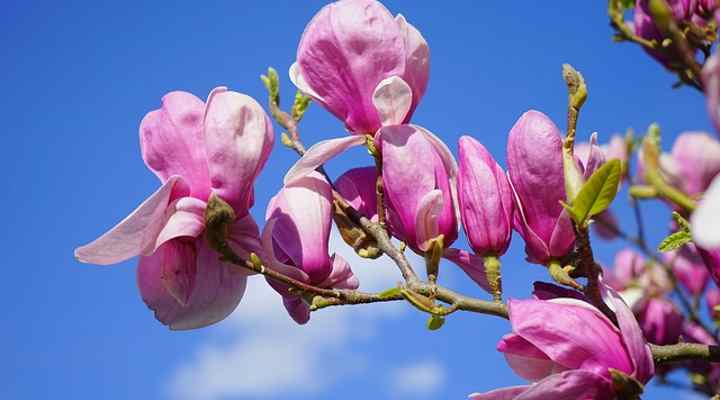
Tulip magnolia (in the picture) and tulip tree are both members of the magnolia family but are different species
The tulip magnolia (Magnolia liliiflora) is a flowering tree different from the tulip tree (Liriodendron). Although the tulip tree is a member of the magnolia family, it’s a different species from the tulip magnolia. Confusion arises because both species of trees have the common name tulip tree. Additionally, Liriodendron tulipifera is also called the tuliptree magnolia.
Tulip Tree Leaves
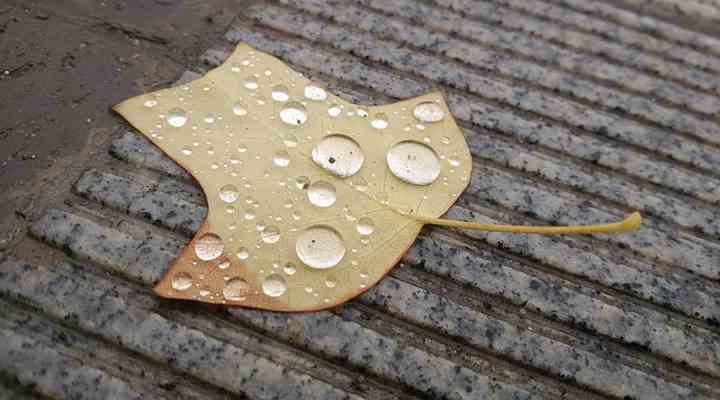
Tulip tree leaf in the fall
A tulip tree’s unique leaves are its most distinctive identifying feature. To identify tulip poplars, look for large, bright green leaves with four lobes and rounded notches. The easily recognizable deciduous leaves measure 3” to 8” (8 – 22 cm) long and 2.3” to 10” (6 – 25 cm) wide.
In the fall, tulip tree leaves turn spectacular shades of yellow and golden-yellow.
Tulip Tree Flowers
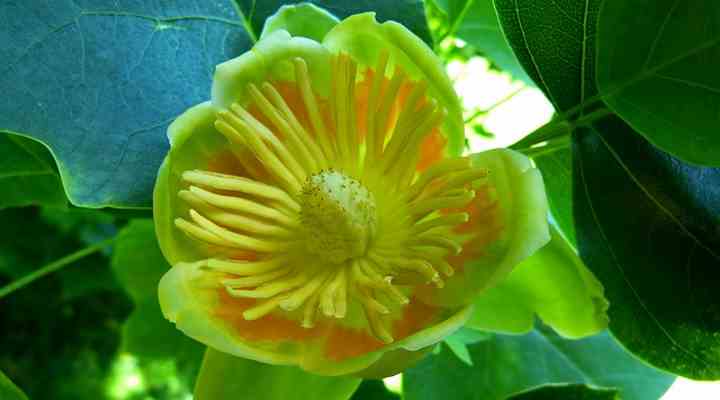
A close up picture of tulip tree flower
Tulip tree flowers look like showy tulip flowers. The tulip-like flower consists of six rounded petals that are a yellow-green color with splashes of orange. Flowers on tulip trees measure 1” to 4” (3 – 10 cm) in diameter. Depending on the zone, tulip trees generally bloom in mid-spring.
In southern states such as Florida, Georgia, and Alabama, tulip poplars may start blooming in late March or early April. However, early tulip tree bloomers may start flowering as early as late January, depending on the cultivar. In zone 4 and 5, tulip trees may bloom as late as June.
When tulip trees bloom, it isn’t easy to see the tree’s pale green or yellow flowers. This is because the blossoms are usually high up on these tall flowering trees and are difficult to recognize amongst the bright green foliage.
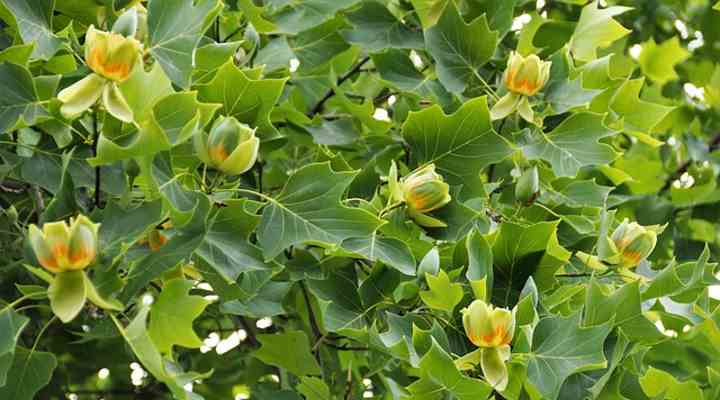
Tulip tree flowers are not easily spotted among the green foliage
Tulip Tree Bark
The tulip poplar tree is identified by its bark which is smooth and green on immature trees. You will also notice that there are whitened grooves on the smooth bark. As the tulip tree grows, the bark develops fissures and becomes an orange-brown color, and the flat ridges become brownish-gray.
Tulip Tree Seeds
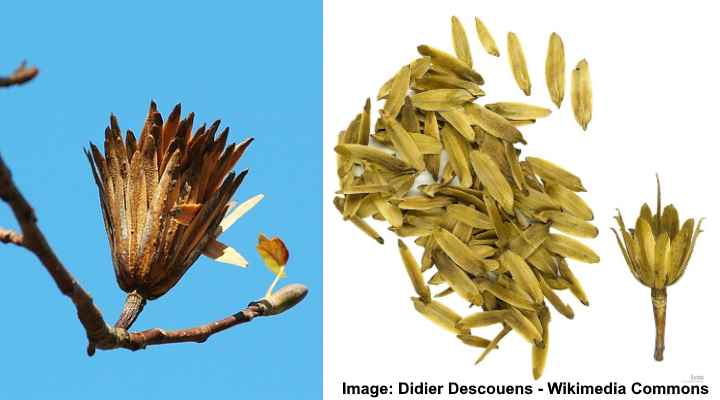
Tulip tree seeds
Tulip poplar trees produce cone-shaped fruits that contain an abundance of winged seeds called samaras. The seeds drop from the trees from September until November. The cone-like seeds add ornamental value to tulip trees after the pretty flowers have finished blooming.
Types of Tulip Trees (with Pictures)
Let’s look in more detail at the two types of tulip poplar trees. The descriptions and pictures of yellow poplars will help you recognize the identifying features of these splendid landscape trees.
Tulip Poplar or Yellow Poplar (Liriodendron tulipifera)
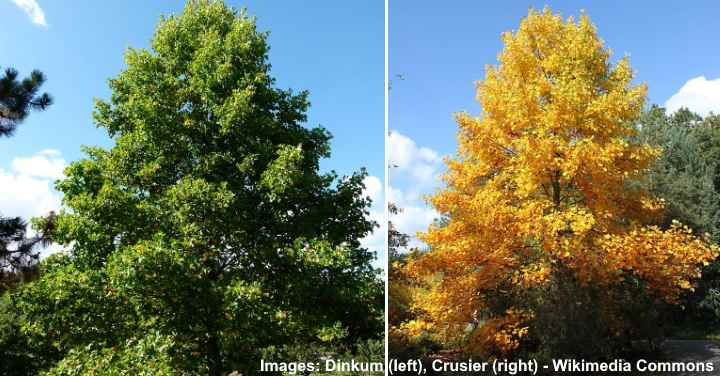
Tulip poplar (Liriodendron tulipifera) trees – summer and autumn foliage
Tulip poplars are identified by their enormous size, pyramidal crown, 4-lobed leaves, and greenish-yellow flowers. Native tulip poplar trees typically grow between 80 and 150 ft. (24 – 45 m) tall and up to 50 ft. (15 m) wide.
Fast-growing American tulip poplar trees thrive in USDA zones 4 through 9.
The tulip poplar (Liriodendron tulipifera) is the tallest hardwood tree native to the eastern US.
The tall tulip poplar trees with their deep root system perform best in moist, well-drained acidic soil. Tulip trees aren’t drought resistant and are sensitive to heat.
Tuliptree sunlight requirements: Tulip poplars grow best in full sun or partial shade. Growth is fastest when the tall trees get around six hours of sunshine daily. Getting plenty of sunlight also ensures that the smooth green leaves are healthy and don’t turn brown.
Tuliptree growth rate: Tulip poplars grow fast, around 25” (63 cm) per year when they are young. As the tulip poplar tree matures, its growth slows and averages between 13” and 24” (13 – 60 cm) a year. Tulip poplars grow for about 15 years before they flower, and the strong, hardy trees can live for 300 years.
Despite its fast growth, tulip poplar tree wood is very light yet strong. The timber color is whitish, pale yellow—hence the common names yellow poplar and whitewood poplar. The fine grain on the timber, ability to stain well, and light weight make tulipwood an excellent wood type for furniture making.
Tulip poplar trees have a robust, deep root system that allows them to grow in harsh conditions. Its roots can grow 100 ft. (30 m) deep with a spread of around 40 ft. (12 m).
Although tulip poplars are enormous trees with a large, spreading canopy, you can grow them in your garden. You can keep the tulip tree shrub size by pruning the deciduous tree back to the ground every two or three years. Or, you can grow dwarf tulip poplar tree cultivars.
Tulip Poplar Leaves

American tulip tree leaves
Tulip poplar trees have distinctive bright green leaves that have four lobes separated by curved notches with smooth margins. The simple tulip tree leaves have recognizable prominent veins stretching from the midriff to each pointed lobe. Yellow poplar leaves are around 6” (15 cm) long and up to 8” (20 cm) wide.
The unique shape of the glossy green poplar leaves gives rise to common names such as fiddle trees because the rounded cut sides have a violin shape. It is also called saddle-leaf tree because the tulip poplar leaf looks like a saddle.
Tulip Poplar Flowers

American tulip tree flower
Tulip poplars have cup-shaped fragrant golden-yellow and green flowers. Six rounded petals form the flower’s shape, and it looks remarkably like a tulip flower. Inside the cup-like flower is a ring of erect stamens and orange markings. The tulip-like flowers are 1.5” to 2” (4 – 5 cm) long.
Tulip poplar flowers are stunning and relatively distinctive, making it easy to identify tuliptrees from real poplars or other landscape trees.
The tree’s botanical name—Liriodendron tulipifera—refers to the unique tree flowers. The name means “lilytree that brings forth tulips.”
Tulip Poplar Seeds
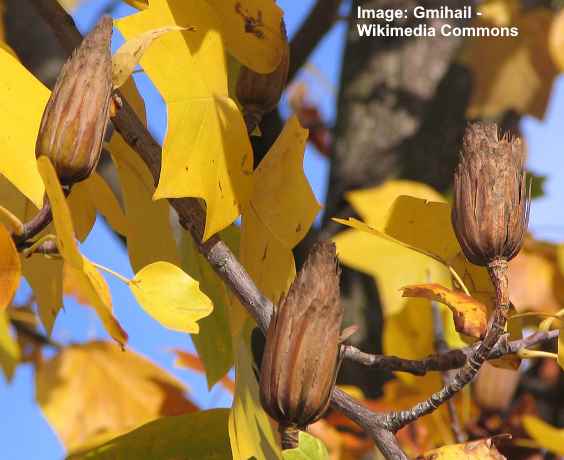
American tulip seed cones
Tulip poplar seeds are winged seeds (samaras) that grow together, forming a cone shape. The scaly, oblong brown fruits are up to 3” (7.5 cm) long, and the individual tuliptree seeds grow between 1” and 3” (2.5 – 7.5) long. The seeds separate in winter and are carried by the wind.
Tulip Poplar Bark
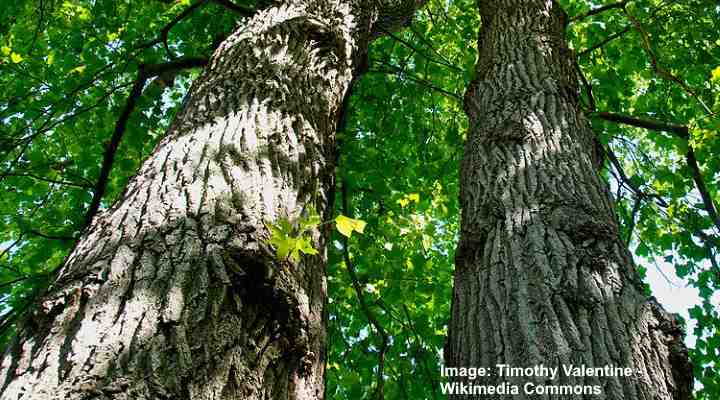
Bark of mature American tulip trees
Yellow poplar bark is smooth and green on immature trees. As the tulip poplar tree matures, the bark develops orangey-brown fissures and flat plates. In time, the bark becomes dark gray with deep furrows running vertically up the straight tree trunk.
Tulip Poplar Identification
Tulip poplar trees are easy to identify due to their distinctive four-lobed leaves, tulip-like yellow flowers, and rough gray bark. In landscapes, tulip poplars are identifiable by their towering size and conical crown. When the golden-yellow leaves drop in the fall, attractive cone-shaped brown fruits grace the bare branches.
Tulip Poplar Diseases
Tulip poplar trees are prone to aphid infestations and scale insects. Tiny flying white or green aphid insects feed on the stems and leaves, causing a buildup of honeydew. This sticky amber substance causes sooty mold issues. You can spot scale insects by unusual bumpy growth on the lower branches.
Canker diseases are common on tulip poplar trees. Canker tree disease is a type of fungal infection that grows between the bark and the wood. Cankers on tulip poplars look like discolored or depressed areas on the bark. Prune any infected branches to keep the tulip tree healthy.
Ensuring that tulip trees grow in the right conditions is the best way of preventing common tree diseases.
Foliage on tulip poplar trees can also show signs of powdery mildew or leaf spot.
Distribution and Habitat of Tulip Poplar Trees
Tulip poplars are native to most states in the eastern United States. Tulip trees grow from northern Florida to New York and west to Louisiana and southern Ontario. You’ll find yellow tulip poplars growing in well-drained soils of deciduous forests and lower mountain slopes.
Tulip Poplar Cultivars
Many yellow tulip cultivars are suitable dwarf trees and small landscape trees, ideal for growing in garden landscapes. Here are some tulip poplar cultivars that grow well in sunny front or backyards.
Tulip Poplar ‘Little Volunteer’ (Liriodendron tulipifera ‘Little Volunteer’)
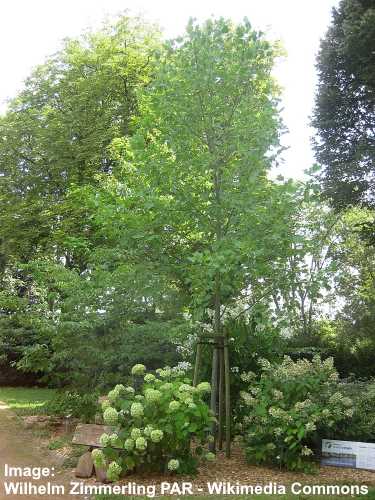
Liriodendron tulipifera ‘Little Volunteer’
The ‘Little Volunteer’ tulip poplar is a dwarf Liriodendron tulipifera cultivar. The fast-growing small tree has all the characteristics of a full-size tulip tree. The dwarf tulip poplar grows 12 ft. (3.6 m) tall and 6 ft. (1.8 m) wide. The pretty, 4-lobed green leaves and yellow tulip-like flowers make this a popular landscaping tree.
Here are some other tulip poplar cultivars you can grow in your yard.
Tulip Tree ‘Aureomarginatum’—Prized for its beautiful, variegated violin-shaped foliage, conical growth habit, and tulip-like yellow-green flowers. This medium-sized tulip tree grows 40 to 60 ft. (12 – 18 m) tall and up to 25 ft. (8 m) wide.
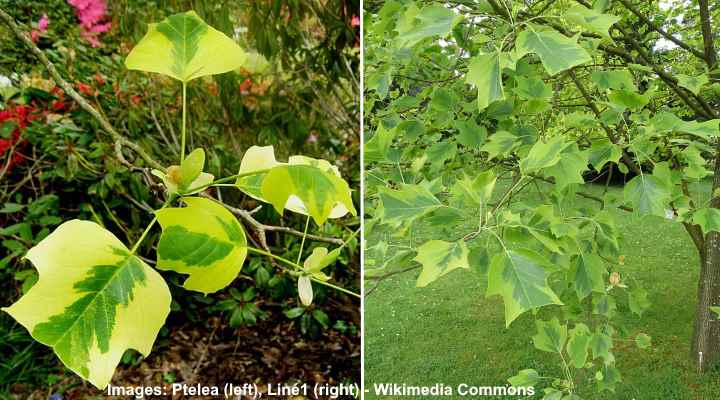
Variegated leaves of Tulip tree ‘Aureomarginatum’
Liriodendron tulipifera ‘Fastigiatum’—A narrow, columnar tulip poplar with lobed leaves, green tulip-shaped flowers, and beautiful yellow fall colors. Grows up to 40 ft. (12 m) high and 13 to 26 ft. (4 – 8 m) wide.
Liriodendron tulipifera ‘Arnold’—A slender upright tulip poplar suitable for narrow spaces. Distinctive 4-lobed leaves, yellow-green flowers that bloom early are features of this tulip tree cultivar. Grows 25 ft. (8 m) tall and 10 ft. (3 m) wide.
Liriodendron tulipifera ‘Leucanthum’—A rare type of tulip poplar with white tulip-shaped flowers and glossy green saddle-shaped leaves. Grows up to 30 ft. (9 m) tall.
‘Florida Strain’—A Florida ecotype tulip poplar suited to hot drier conditions of the south. Grows 80 to 100 ft. (24 – 30 m) tall and 30 to 50 ft. (9 – 15 m) wide.
Chinese Tulip Tree (Liriodendron chinense)
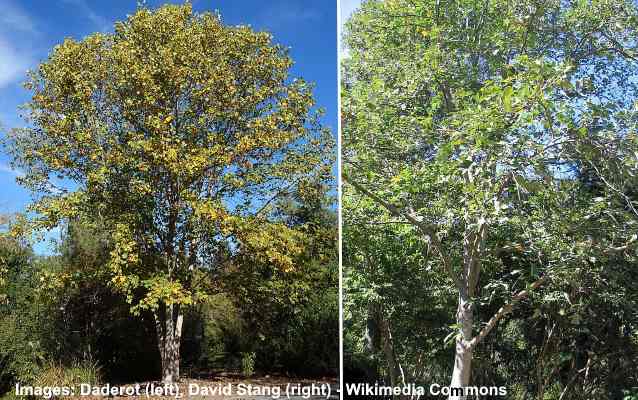
Chinese tulip tree (Liriodendron chinense)
The Chinese tulip poplar—also called the Chinese whitewood—is a tall deciduous tree with shiny lobed leaves, small tulip-shaped flowers, and light gray fissured bark. The tree with its conical crown grows 50 to 70 ft. (15 – 21 m) tall and up to 40 ft. (12 m) wide.
Chinese tulip trees thrive in USDA zones 6 through 9. Like the yellow poplar, the trees grow best in full sun and well-drained soils. However, it’s not as cold-hardy as the American tulip tree.
The difference between the Chinese tulip poplar and the American tulip poplar is its size. The Chinese tuliptree is slightly smaller, has smaller flowers but larger leaves. Additionally, the Chinese tulip tree flowers don’t have the orange markings that the American tulip tree has.
Chinese Tulip Tree Leaves
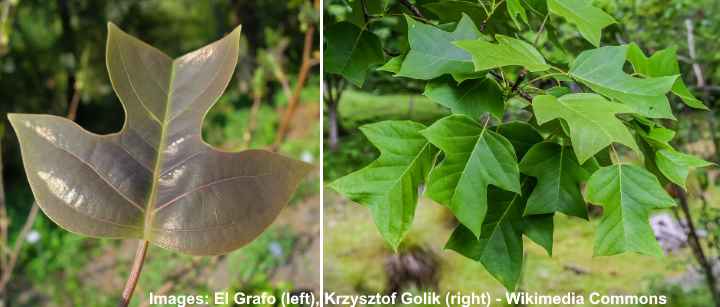
Chinese tulip tree leaves
Chinese tulip poplar leaves are large, glossy green leaves with four deep lobes. Chinese tulip tree leaves grow up to 18” (45 cm) broad. They emerge bronze-red on branches in spring before turning green in summer and golden yellow in the fall.
The dense, leafy foliage and spreading branches make the Chinese tulip poplar a majestic shade tree for large, open landscapes.
Chinese Tulip Tree Flowers
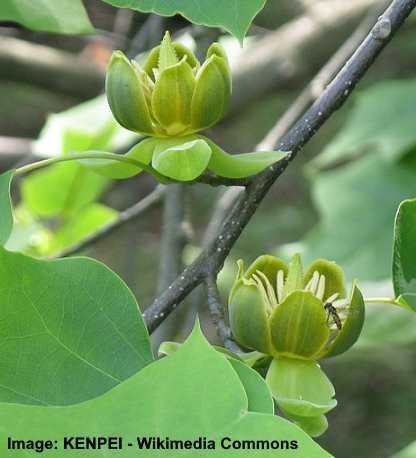
Chinese tulip tree flowers
Chinese tulip poplar flowers are small cup-shaped flowers that look like tulips. The yellowish-green flowers bloom in late spring or early summer. Individual tulip tree flowers measure 1.5” (4 cm) long. The flowers are barely noticeable on tall, mature trees because they blossom high up on the tree.
Chinese Tulip Tree Seeds
Chinese tulip poplar seeds are brown winged seeds that grow in cone-shaped brown clusters. After the yellow tuliptree leaves drop in the fall, the clusters of cone-like seeds add decorative value to these enormous trees.
Chinese Tulip Tree Bark
The straight trunk of Chinese tulip poplars has smooth gray-green bark with pale-colored vertical fissures. In time, the tuliptree’s bark becomes rougher and develops ridges that crisscross up the tree. Chinese tulip tree stems and branches are a reddish-brown color.

Chinese tulip tree bark
Related articles:
